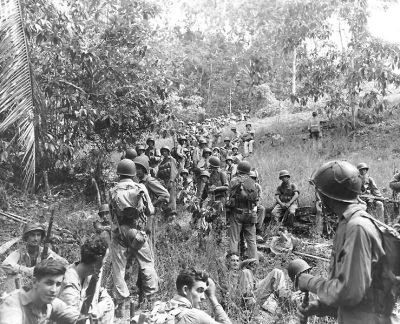War in the East – Part Two
The Island War
In July, the Japanese sought to overrun New Guinea. There, Australian and US troops fought hard to stop the invaders. The fighting went on for months in the steaming jungles and on the mountainous heights. The Australians carried the burden of this prolonged campaign, which would extend into a two-year fight for New Guinea. General Douglas MacArthur would lead this fight. MacArthur realized that no return to the Philippines would ever be possible until New Guinea had been rid of the Japanese infestation.
A series of battles were fought in the CBI (China-Burma-India) theater of war. These were not decisive battles in the sense that they affected over all strategy. They were, however, some of the most intense casualty producing conflicts of the war. Fraught with military jealousies and rivalries, the Allies offered little in the way of cohesive strategy or final victories. What this fighting did do was to tie up thousands of Japanese soldiers when they were so desperately needed in the Pacific to stem the tide of Allied progress through the island chains.
{default}The Solomons: A Small Beginning
To penetrate the strong outer defensive ring that Japan had established by the summer of 1942, the Americans made a less than impressive attack into the Solomon Islands. When it became known that the Japanese were building an airfield on the island of Guadalcanal, it was decided that ready or not, America would have to go to that island, capture it, and stop any further Japanese extension of power.
Airfields in the southern Solomon Islands would jeopardize shipping from the United States to Australia, isolating both Australia and New Zealand, threatening their very existence. Just as important was the fact that these two major friendly islands were the starting point at that time in history for any offensives operations towards Japan.
The battle for Guadalcanal was one of the fiercest of the war in the Pacific. For a detailed understanding on what took place on Guadalcanal, you should read the fine article in this game written by Bruce Hodgman on that theme.

US Marines on Guadalcanal
Most of 1943 was occupied with the continued advance of Allied forces in New Guinea and the final conquest of the Solomon Islands, including New Georgia and Bougainville. Very slowly the Allies were building a ring around the Japanese bastion of Rabaul. Allied leaders felt that surrounding Rabaul and isolating it from any help from the mother islands would insure its fall without an attack on it. Such a move would have been very costly in Allied casualties. Cutting it off was the easier method of Approach.
Gaining Momentum
By September 1943, things were beginning to look grim for the Japanese. Their navy had suffered horrendous losses, which were not being replaced at an adequate rate. With Italy’s surrender and German forces being ground down in Russia, it appeared that Japan was on her own. There would be no help from her allies. American submarines had by this time sunk over 800,000 tons of Japanese shipping and had so crippled the transport arm of the fleet that little could be done to either fortify defensive positions or challenge an ever bolder enemy.
The United States, on the other hand, with all her industries and people devoted to winning the war, was developing the largest, most powerful armed forces in the world. Unhampered by attacks from the air, the factories turned out a never ending stream of material to equip the soldiers, sailors, Marines and airmen with all that was needed to win the war.
The Gilberts: The First Steps
The next step toward the Philippines would be the taking of the Gilbert Islands. Three atolls (or smaller island groups) to be attacked were Abemama, Makin, and Tarawa. Admiral Turner’s 5th amphibious force would do the fighting. The bloodiest fighting of this campaign would be on Betio, principal island of the Tarawa chain. 18,000 Marines of the Second Division assaulted the island. After one of the costliest amphibious assaults in history, the Marines fought for three long days.
Betio, small in size, would claim the lives of over 1,000 Marines, and all of the enemy force except 17 wounded soldiers and 129 Korean Laborers. The rest of the 4,800-man force died on the island. It was here, as never before, the intensity and devotion of the Japanese fighting man was etched in his own blood and that of his enemy.
A new strategy evolved for the advance in the Pacific. Islands deemed less important, or too strongly held, were simply bypassed. It was decided that rather than pay the cost in men’s lives, these enemy strongholds would be left to "wither on the vine."
Such a place was the Japanese stronghold at Rabaul. Even though earlier plans called for its capture, it was decided to let air and naval strength pound it at a distance. Thus, from February 1944 until the end of the war, the enemy at Rabaul was surrounded, attacked from the air constantly, and completely neutralized as a threat to the Allied offensive. Here was an instance of a significant defeat without the use of ground forces. It was an evil omen for the increasingly under equipped Japanese forces.
[continued on next page]

